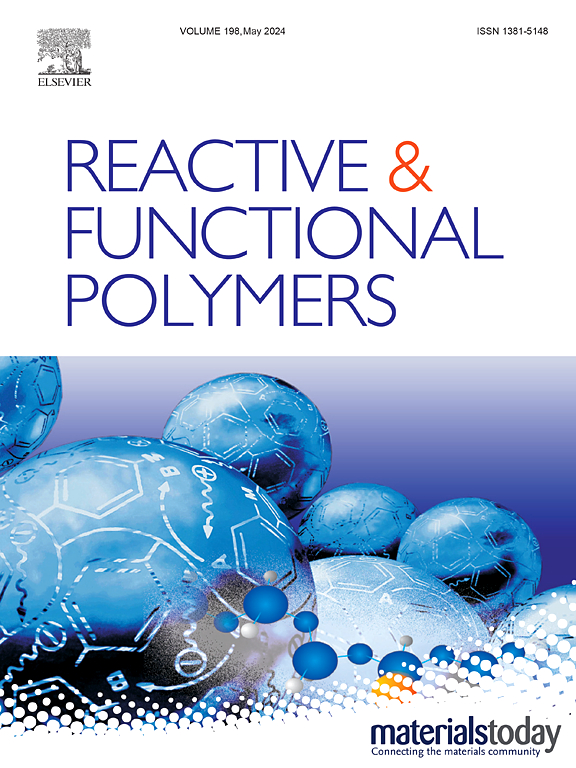In situ polysaccharide-based double-network hydrogels as a sustained kartogenin delivery system for cartilage tissue engineering
IF 5.1
3区 工程技术
Q1 CHEMISTRY, APPLIED
引用次数: 0
Abstract
In situ forming biodegradable hydrogel scaffolds are crucial in tissue engineering and drug delivery systems, with extensive applications in articular cartilage (AC) repair. Polysaccharide-based hydrogels are ideal materials for cartilage tissue engineering owning to their biochemical and structural resemblance to the native extracellular matrix (ECM). In this study, a double-network (DN) hydrogel was fabricated through Schiff base reaction and photocrosslinking, utilizing glycidyl methacrylate-modified chitosan (GCS) and aldehyde-modified hyaluronic acid methacrylate (AHM) as precursors. To prepare the drug-loaded hydrogel, we grafted the bioactive factor kartogenin (KGN) onto GCS, generating KGN-conjugated GCS (KGCS), which subsequently formed a crosslinked network with AHM. In contrast to conventional hydrogels encapsulating either drug alone or drug-loaded microspheres, the proposed hydrogel demonstrated a more stable and sustained release profile. Furthermore, the physicochemical properties of both hydrogels were systematically characterized, comprising morphology, mechanical properties and swelling rate. The biocompatibility of hydrogels was comprehensively investigated through in vitro cell proliferation assays, hemocompatibility analysis, and in vivo evaluation of subcutaneous implant. Subsequently, a cartilage defect model was utilized to assess their efficacy in cartilage regeneration. In summary, the two DN hydrogels exhibited suitable porous structure, mechanical properties, and swelling rates. Furthermore, they demonstrated excellent biocompatibility and significantly promoted cartilage defect regeneration.

基于原位多糖的双网络水凝胶作为软骨组织工程中持续的核原蛋白递送系统
原位形成的可生物降解水凝胶支架在组织工程和药物输送系统中至关重要,在关节软骨(AC)修复中有着广泛的应用。多糖基水凝胶具有与天然细胞外基质(ECM)相似的生化和结构,是软骨组织工程的理想材料。以甲基丙烯酸缩水甘油酯修饰的壳聚糖(GCS)和醛修饰的甲基丙烯酸透明质酸(AHM)为前体,通过希夫碱反应和光交联制备了双网状(DN)水凝胶。为了制备载药水凝胶,我们将生物活性因子kartogenin (KGN)接枝到GCS上,生成KGN-conjugated GCS (KGCS),随后与AHM形成交联网络。与传统的水凝胶单独包封药物或载药微球相比,所提出的水凝胶表现出更稳定和持久的释放特征。此外,系统表征了两种水凝胶的物理化学性质,包括形态、力学性能和膨胀率。通过体外细胞增殖试验、血液相容性分析和皮下植入物的体内评价,全面考察了水凝胶的生物相容性。随后,利用软骨缺损模型评估其在软骨再生中的效果。综上所述,两种DN水凝胶具有合适的多孔结构、力学性能和溶胀率。此外,它们表现出良好的生物相容性,并显著促进软骨缺损的再生。
本文章由计算机程序翻译,如有差异,请以英文原文为准。
求助全文
约1分钟内获得全文
求助全文
来源期刊

Reactive & Functional Polymers
工程技术-高分子科学
CiteScore
8.90
自引率
5.90%
发文量
259
审稿时长
27 days
期刊介绍:
Reactive & Functional Polymers provides a forum to disseminate original ideas, concepts and developments in the science and technology of polymers with functional groups, which impart specific chemical reactivity or physical, chemical, structural, biological, and pharmacological functionality. The scope covers organic polymers, acting for instance as reagents, catalysts, templates, ion-exchangers, selective sorbents, chelating or antimicrobial agents, drug carriers, sensors, membranes, and hydrogels. This also includes reactive cross-linkable prepolymers and high-performance thermosetting polymers, natural or degradable polymers, conducting polymers, and porous polymers.
Original research articles must contain thorough molecular and material characterization data on synthesis of the above polymers in combination with their applications. Applications include but are not limited to catalysis, water or effluent treatment, separations and recovery, electronics and information storage, energy conversion, encapsulation, or adhesion.
 求助内容:
求助内容: 应助结果提醒方式:
应助结果提醒方式:


